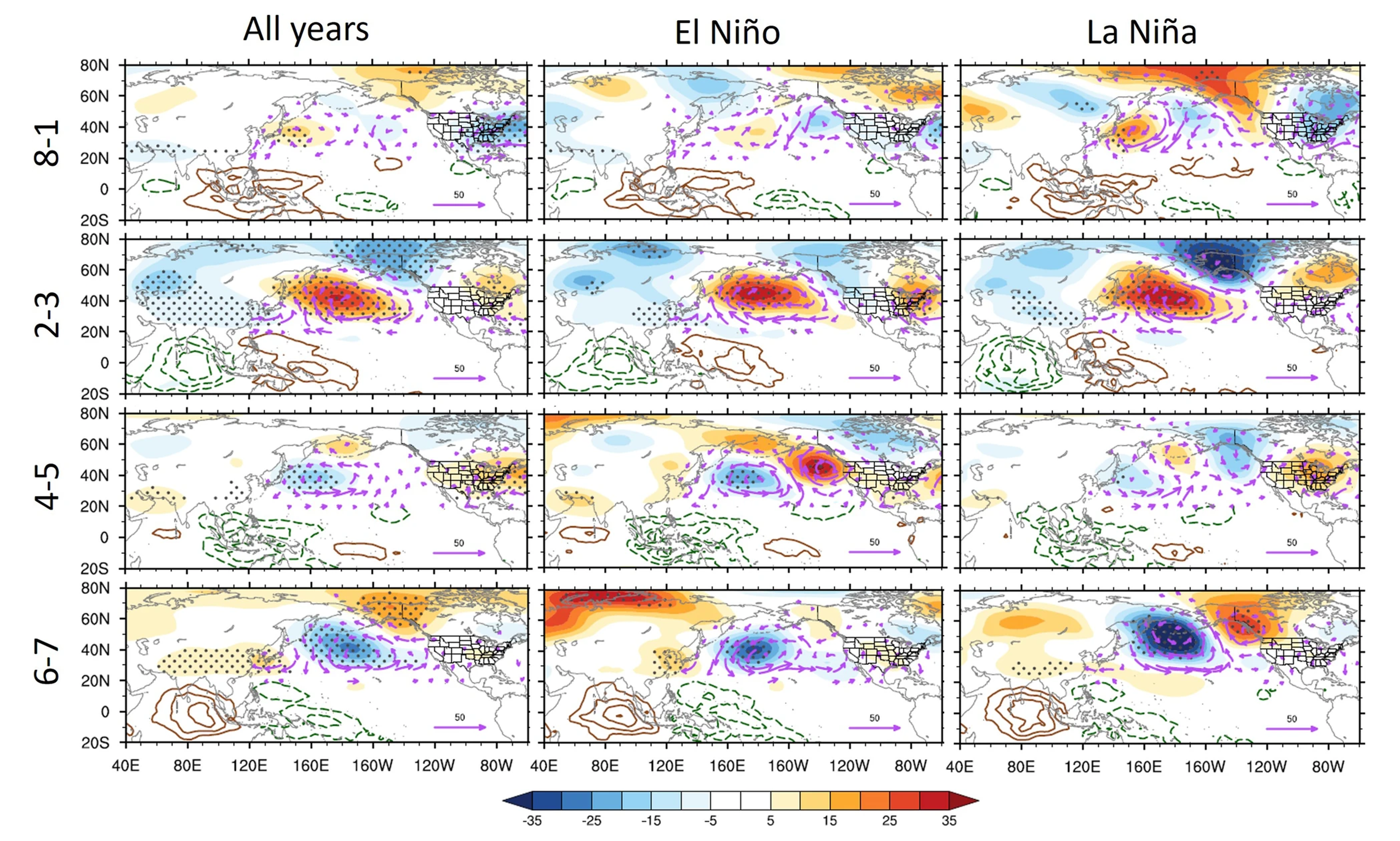CW3E Publication Notice
Association of western US compound hydrometeorological extremes with Madden-Julian oscillation and ENSO interaction
June 18, 2024
A new paper entitled “Association of western US compound hydrometeorological extremes with Madden-Julian oscillation and ENSO interaction” was recently published in Nature Communications Earth & Environment and authored by CW3E researcher Jiabao Wang, Mike DeFlorio (CW3E), Alexander Gershunov (CW3E), Kristen Guirguis (CW3E), Luca Delle Monache (CW3E Director of Research), and Marty Ralph (CW3E Director). As part of CW3E’s 2019-2024 Strategic Plan, CW3E seeks to improve understanding of the subseasonal (2-6 week lead) and seasonal (6-week to 6-month lead) predictability of extreme weather over the western US and develop a comprehensive understanding of the physics and the probabilistic and statistical characteristics of extreme events in the West to inform current and future resource and risk management. This study discovered a strong linkage between variability in the occurrence frequency of boreal winter hydrometeorological (precipitation and temperature) compound extremes over the western US and the dominant subseasonal predictability source in the tropics, Madden-Julian oscillation (MJO), and showed that the linkage is largely dependent on ENSO phases. This research was sponsored by the California Department of Water Resources Atmospheric River Program.
Four different types of compound extremes are examined in this study: compound dry conditions and warm spells (dry-hot), compound extreme precipitation and cold spells (wet-cold), compound dry conditions and cold spells (dry-cold), and compound extreme precipitation and warm spells (wet-hot). We find that the occurrence frequency of compound extremes over the western US changes significantly with the eastward movement of MJO convection. When the MJO is located over the Maritime Continent (Phases 4-5), the frequency of dry-hot extremes tends to increase and wet-cold extremes tend to decrease over most of the western US (Fig. 1). When the MJO is located over the western Pacific (Phases 6-7), more wet-cold extremes and less dry-cold extremes are likely to occur over the southwestern US. The MJO-compound extreme relationship, however, changes significantly in response to different ENSO phases. The ENSO impacts are manifested as either opposite-sign signals of extreme event frequency in response to MJO or different magnitudes of MJO influence between the two ENSO phases (Fig. 1).
Variations in the MJO-compound extreme relationship associated with ENSO originate from the different MJO teleconnection patterns (Fig. 2). When the MJO is over the Indian Ocean or western Pacific (Phases 2-3 and 6-7), its teleconnections tend to extend more eastward in El Niño years and MJO impacts tend to persist longer during El Niño; while in La Niña, although the amplitude of MJO teleconnections is stronger, the responses are more offshore and thus MJO impacts are generally weaker. As a result, the response in compound extremes is more significant during these MJO phases in El Niño years than in La Niña years. For the other MJO phases (Phases 8-1 and 4-5), an opposite response in MJO teleconnections along the US West Coast is seen between two ENSO phases, leading to the opposite response in the compound extremes.
Figure 1. Averages of absolute changes in compound extreme frequency (unit: %) over a California and b the Pacific Northwest (Washington/Oregon). Four different categories of compound extremes are shown: wet-cold, dry-hot, wet-hot, and dry-cold extremes. Brown bars indicate the changes after active MJO phases in all years; Blue and green stripped bars represent the seasonal changes in active El Niño and La Niña years, respectively; Blue and green solid bars show the averages for each MJO phase in active El Niño and La Niña years, respectively. The numbers in each figure represent the climatological frequency of that compound extreme type over that region. The asterisks indicate the significance of the changes based on the bootstrap test.
The findings in this study uncover a strong intraseasonal variation in the MJO-related compound extremes and demonstrate a need to consider the impacts of both the intraseasonal modulation and the seasonal background state when predicting temperature and precipitation at subseasonal and seasonal lead times relevant to water managers and other end users across the western US.
Figure 2. 5–9-day averaged lagged response of 25-90-day filtered 500hPa geopotential height anomalies (Z500a; shading: m) and 850–700-hPa integrated vapor transport anomalies (IVTa; vectors: kg m−1 s−1) to MJO activity at day 0 [OLR contour: green (brown) represents enhanced (suppressed) convection, interval: 5 W m−2] in all years, El Niño years, and La Niña years. The dotted areas represent the significant Z500a exceeding the 90% confidence level. Vectors that are shown are significant IVTa.
Wang, J., DeFlorio, M. J., Gershunov, A., Guirguis, K., Delle Monache, L., & Ralph, F. M. (2024). Association of western US compound hydrometeorological extremes with Madden-Julian oscillation and ENSO interaction. Communications Earth & Environment, 5, 314. https://doi.org/10.1038/s43247-024-01449-w


